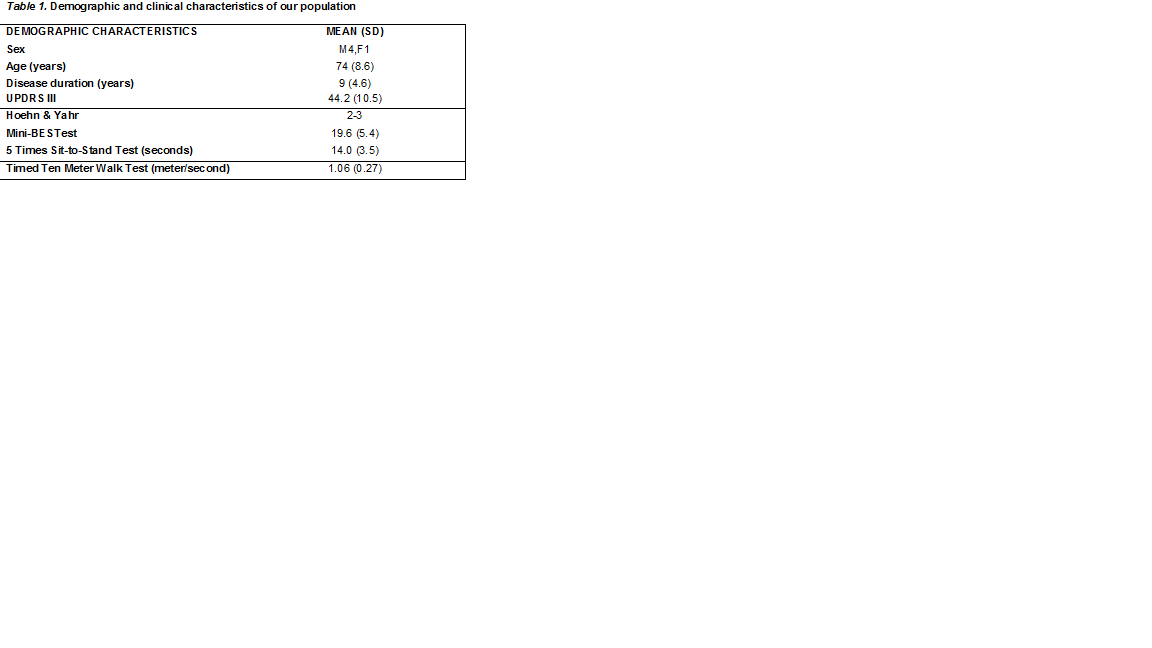Session Information
Date: Tuesday, June 6, 2017
Session Title: Therapy in Movement Disorders
Session Time: 1:45pm-3:15pm
Location: Exhibit Hall C
Objective: To explore the feasibility of pairing repetitive transcranial magnetic stimulation (rTMS) back-to-back with standard of care physical therapy (PT) for posture instability and gait disorders (PIGD) in PD.
Background: PIGD rehabilitation is offered by PT programs that are standardized and tailored on patient’s deficits. However, benefits are often limited. rTMS has shown potential to modulate motor learning in both healthy individuals and PD (1,2).The clinical applicability of such paired paradigms in PD, outside laboratory settings, have not been tested.
Methods: Double-blind, randomized, sham-controlled study. This is a collaborative study between our movement disorder institute and the rehabilitation institute. PD patients with PT prescription for PIGD were screened and enrolled. After each PT session, participants were directed to our Lab to randomly receive rTMS (experimental group) or sham rTMS (control group) as soon as possible. The duration of rTMS sessions was 20 minutes. Patients and PT providers were blinded to the intervention. Preliminary data of safety, tolerability and study adherence was analyzed.
Results: Demographic characteristics are detailed in [table1]. A total of 41 PT sessions were performed in 5 patients. All 41 sessions were paired with rTMS (100% of rTMS compliance). One subject withdrew consent citing lack of motivation continue PT. The average time between PT and TMS/sham at the first session was 23 minutes (10 to 40 minutes) when TMS mapping and threshold were performed. At the following sessions, this was 12.7 minutes (4 to 25 minutes). Study procedures were well tolerated; there were only 2 mild adverse events (AE): neck pain and 1 fall.
Conclusions: Combining rTMS therapy with prescribed rehabilitation therapies hold promise for clinical use. Some practical issues must be initially addressed to determine feasibility. Scheduling operability, were TMS neuromodulation and PT should be administered within a brief temporal window. Furthermore, tolerance and adherence of pairing PT and rTMS can be challenging for PD patients as rTMS prolongs patient’s stay and might cause mild AE. A limitation of our study is the sample size which prevents efficacy analysis. Our preliminary results show that systematic rTMS adjuvancy on multiple sessions of PT is a feasible and safe intervention. Our results grant a further efficacy study.
References: Moisello C, Blanco D, Fontanesi C, Lin J, Biagioni M, Kumar P, Brys M, Loggini A, Marinelli L, Abbruzzese G, Quartarone A, Tononi G, Di Rocco A, Ghilardi MF; Sensory Motor Integration Lab (SMILab). TMS enhances retention of a motor skill in Parkinson’s disease. Brain Stimul. 2015 Mar-Apr;8(2):224-30.
To cite this abstract in AMA style:
A. Cucca, H. Migdadi, T. Biller, S. Agarwal, P. Kumar, A. Son, M. Ko, E. Gallo, S. Fisher, A. Di Rocco, M. Biagioni. Pairing TMS and physical therapy for treatment of gait and balance disorders in Parkinson’s Disease: a randomized pilot trial [abstract]. Mov Disord. 2017; 32 (suppl 2). https://www.mdsabstracts.org/abstract/pairing-tms-and-physical-therapy-for-treatment-of-gait-and-balance-disorders-in-parkinsons-disease-a-randomized-pilot-trial/. Accessed January 4, 2026.« Back to 2017 International Congress
MDS Abstracts - https://www.mdsabstracts.org/abstract/pairing-tms-and-physical-therapy-for-treatment-of-gait-and-balance-disorders-in-parkinsons-disease-a-randomized-pilot-trial/

